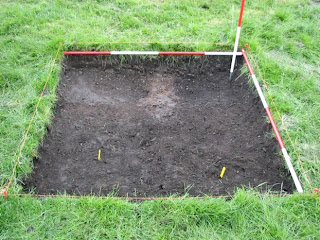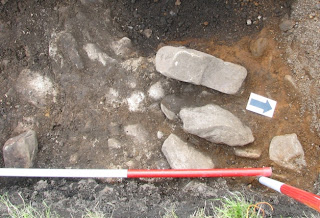Today, we had a great day walking around Roughlee, Barley and Newchurch with our friends from the Upper Wharfedale Field Society. Pam organized the walk, setting the Pendle witches story in the context of the sixteenth and seventeenth century development of this part of the forest. http://en.wikipedia.org/wiki/Pendle_witch_trials We were blessed with a breezy and generally sunny day in which good conversation blended history and archeology with last nights superb Olympic opening ceremony!
We began at Roughlee Old Hall. This is connected with Alice Nutter, one of those executed for witchcraft. She was unusual, among those accused, in being comparatively wealthy, the widow of a tenant yeoman farmer. She made no statement either before or during her trial, except to enter her plea of not guilty. Despite its sad and gruesome associations, it is nevertheless a lovely late C16 house http://www.geograph.org.uk/photo/67348
As we climbed over the hill from Barley car park to the village of Newchurch, we had great views of Pendle Hill and the forest landscape where the C13 Barley and Wheatley vaccaries could easily be picked out. The vaccaries were cow farms producing draught animals, first for the De lacy overlords and then the King. Those caught up in the witches trials were the descendants of the old vaccary keepers.
Another highlight was St. Mary's Church, Newchurch with its famous 'Eye of God' located in the late medieval tower. The rest of the church is classical and surprisingly urbane for such a rural location. Well worth a visit. There is even a C17 Nutter gravestone in the pretty churchyard. http://en.wikipedia.org/wiki/St_Mary's_Church,_Newchurch_in_Pendle
Lunch was at Faugh's quarry. It is here that the witch Demdike claimed to have met the Devil in the shape of a ‘boy wearing a coat half black, half brown who said his name was Tibb’. Demdike sold her soul to Tibb in return for anything she desired. We settled for sandwiches and a drink!
Throughout the walk we could see the development of the local vernacular through the rich heritage of C17 and C18 houses and weavers cottages. We finished with a short drive to the Pendle Heritage Centre, Barrowford which is set in the ancient house, Park Hill. It has exhibitions on both the witches and the traditional houses of the locality... and a pretty good cafe too! http://www.htnw.co.uk/phc.html
Photos by Alex.
A blog about the heritage and archaeology of Pendle Hill and Pendle Forest, Lancashire 2010 - 2013
Welcome
the blog of the Friends of Pendle Heritage Centre Archaeology Group.
Search This Blog
Saturday, July 28, 2012
Friday, July 13, 2012
Bloomery Blog Thursday 12th July 2012
Bloomery Blogger Report 4 - Here comes the rain again...
After Tuesday's floods, there was enough dry weather on Wednesday and Thursday for the team to finish the excavation, back-fill and leave the site in good condition. The forecast remains poor, so it made sense to close down the excavation at this point rather than explore further.
Wednesday started out with the team drying out trenches. Back-filling Trench 11 was was completed with Trevor bringing in the tractor.
Trench 12 was also largely back filled while Trench 12a, a little extension (see yellow bucket above) was taken down to some archaeology. A bit of a structure, possibly the remains of an entrance, was exposed, recorded, and removed (above).
In Trench 13 at the top of the slope, two hearths were exposed (above, bottom left), either for roasting ore or for cooking. Trench 13a, another extension (being excavated by two people in the photo above) was opened to fully expose these. The hearths were about 60mm thick. Finally, Trenches 13 and 13a were both closed down and back-filled bringing the excavation to a close.
Though the premature end disappoints a little, our heroic diggers had defied the worst weather for a long time, added to their number and successfully extracted the last pieces of information from this site. The rain brought just one benefit to this happy band...
plenty of time to explain to their Australian member the finer points of cricket!
After Tuesday's floods, there was enough dry weather on Wednesday and Thursday for the team to finish the excavation, back-fill and leave the site in good condition. The forecast remains poor, so it made sense to close down the excavation at this point rather than explore further.
Wednesday started out with the team drying out trenches. Back-filling Trench 11 was was completed with Trevor bringing in the tractor.
Trench 12 was also largely back filled while Trench 12a, a little extension (see yellow bucket above) was taken down to some archaeology. A bit of a structure, possibly the remains of an entrance, was exposed, recorded, and removed (above).
In Trench 13 at the top of the slope, two hearths were exposed (above, bottom left), either for roasting ore or for cooking. Trench 13a, another extension (being excavated by two people in the photo above) was opened to fully expose these. The hearths were about 60mm thick. Finally, Trenches 13 and 13a were both closed down and back-filled bringing the excavation to a close.
Though the premature end disappoints a little, our heroic diggers had defied the worst weather for a long time, added to their number and successfully extracted the last pieces of information from this site. The rain brought just one benefit to this happy band...
plenty of time to explain to their Australian member the finer points of cricket!
Tuesday, July 10, 2012
Bloomery Blog Monday 9th July 2012
Bloomery Blogger Report 3 - the Magnificent 7!
I never even made it to site today, having got stuck at work. However, I write armed with feedback from our magnificent trench warriors. PUBLIC NOTICE: I have been asked to mention that numbers were down to just 7 today so anyone who wants a go, should come on down sometime after 10am. You know it makes sense!
Now, the story of the three trenches is as follows...
Trench 11 at the bottom of the slope produced bloomery slag, as expected (see photo). There is an industrial beauty in wet slag, exposed to the air for the first time in 700 odd years. Trench 12, the middle one, hit natural ground, though not without coming across bright orange stains (see photo) which some think are the remains of crushed iron ore. The trench has now been back filled. Trench 13 at the top of the slope was excavated down from the clay and stones of context 2 to even more stones at context 3! (see photos) However, our eternally optimistic excavator tells me that, last year below this context there was Medieval pot. As if to prove the point, a body shard was found under this layer of stones today.
With the very loose interpretation allowed for Bloggers, it seems we have signs of habitation at the top of the slope, possible signs of ore crushing halfway down and slag at the bottom. Simple really!
Btw, don't miss the cute baby swallows at the bottom of the page.
I never even made it to site today, having got stuck at work. However, I write armed with feedback from our magnificent trench warriors. PUBLIC NOTICE: I have been asked to mention that numbers were down to just 7 today so anyone who wants a go, should come on down sometime after 10am. You know it makes sense!
Now, the story of the three trenches is as follows...
Trench 11 at the bottom of the slope produced bloomery slag, as expected (see photo). There is an industrial beauty in wet slag, exposed to the air for the first time in 700 odd years. Trench 12, the middle one, hit natural ground, though not without coming across bright orange stains (see photo) which some think are the remains of crushed iron ore. The trench has now been back filled. Trench 13 at the top of the slope was excavated down from the clay and stones of context 2 to even more stones at context 3! (see photos) However, our eternally optimistic excavator tells me that, last year below this context there was Medieval pot. As if to prove the point, a body shard was found under this layer of stones today.
With the very loose interpretation allowed for Bloggers, it seems we have signs of habitation at the top of the slope, possible signs of ore crushing halfway down and slag at the bottom. Simple really!
Btw, don't miss the cute baby swallows at the bottom of the page.
Trench 13
Trench 12
Trench 11
Baby Swallows
Monday, July 9, 2012
Bloomery Blog Sunday 8th July 2012
Bloomery Blogger Report 2
I arrived a little late today and people were just finishing. At 2pm, showers had begun to fall and there was a certain tennis match to watch! Three 2m x 2m squares had been evenly spaced out on the slope running down to the stream. They had been arranged to cover the gaps between the trenches of the last two digs; in the hope something new may be found there. The one nearest the beck is called Trench 11. this is an area of slag. Trench 12 is in the middle roughly where the land gives way to the slag deposits. Trench 13 is at the top where there is compacted clay and stones.After stripping, all three were taken down to the first level just below the soil and subsoil. Various shards of pottery of various dates were found, including a small rim of what appeared to be medieval Pennine Gritty Ware (a lovely name!). Some fancied that a rounded speckly stone about the size of a cricket ball was artificial and possibly used for crushing ore. That's what I like about archaeology... lot's of opinion and very little hard fact!
People were excavating to the next level when the showers came and things got too wet to continue.
 Lower picture taken just as the rain came down.
Lower picture taken just as the rain came down.Trench 12 - remains of earlier dig on the right

Trench 13 - compacted clay over rounded stones

Sunday, July 8, 2012
Bloomery Blog Saturday 7th July 2012
Bloomery Blogger Reports
I popped over to the excavation on Saturday morning to see how things were going. The Pendle countryside was very pretty in the sunshine and the area of the dig was like a little Garden of Eden; with green fields, a babbling brook, swallows skimming overhead, lambs, rabbits and hens. The Old House cottage garden was also suitably in flower.People were appropriately relaxed and just beginning to lay things out, having abandoned the task on Friday because of the rain. Trevor, the farmer, had mowed the grass and they found the datum points from last year. They laid out the grid nice and accurately while I threw sticks to the farm collie, Bonnie and stroked the cat, Tyger. Bonnie will happily return sticks for an eternity.
The there was deep discussion with the overlaid plans from the past two excavations, as people made up their minds what the strategy would be. Eventually, three 2m squares were laid out on three different un-excavated parts of the site. If only we had a digger like on Time Team someone said as they got out the spades and I quietly slipped away...





Thursday, July 5, 2012
Friends, Romans and Countrymen...
Don't miss this lecture
http://www.senhousemuseum.co.uk/2012-lecture-9-july-2012.html
Don't miss this lecture
http://www.senhousemuseum.co.uk/2012-lecture-9-july-2012.html
Subscribe to:
Comments (Atom)



























